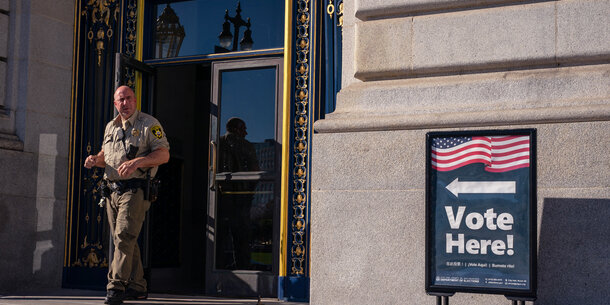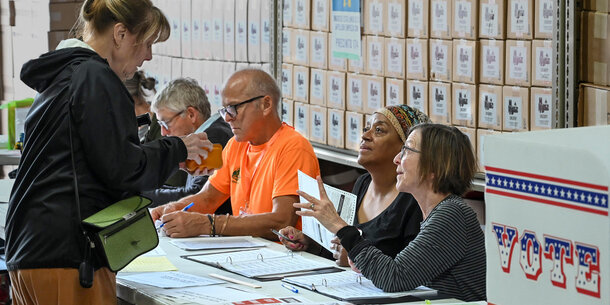Last week, the company Cyber Ninjas finally released a “report” on their partisan review of the 2020 election that the Arizona Senate commissioned. The firm’s top three findings, according to its own ranking of importance, are textbook examples of how purveyors of voter fraud myths misunderstand data — if there were a textbook about data illiteracy.
The most facially naïve of these findings is the one titled “Voters That Potentially Voted in Multiple Counties” — labelled as one of two findings of “high” importance, just below the so-called “Critical” finding of “Mail in Ballots Voted from Prior Address.” It even went so far as to claim “5,295 ballots impacted.”
But it turns out that this “finding,” and the attendant recommendation that a list of 10,342 voters be “fully reviewed,” is based on failure to comprehend basic probability and patterns of name popularity. Cyber Ninjas simply looked for Arizona voters who shared a first, middle, and last name and birth year with another voter in the 2020 election, and it found 10,342 of them.
The Cyber Ninjas thinks that warrants a “full review,” and goes so far as to claim these people may represent the same person, voting more than once in the election. But their suspicion is completely baseless, and just evidence that they are ignorant of the “Birthday Problem,” a basic statistical concept.
If we look at a group of people with a common name, such as Robert Smith, we shouldn’t be surprised that two of them share a birthday. In fact, we should expect it.
A lot of people find this counterintuitive, hence the name “Birthday Problem,” or sometimes “Birthday Paradox.” But Cyber Ninjas did something even more outrageous. It only checked for birth year matches among Arizona voters who share a full name and participated in 2020. It is even more common to share a birth year with someone than to share a full birthdate including the month and day.
If we assume that any group of voters who share a full name contains people evenly distributed from 18 to 75, the group only has to be 10 voters for the odds of a birth year match to be over 50 percent. We’d expect a match among just 16 voters 90 percent of the time. But it’s even more common than that, when you remember that there are variations in birth rates and popular baby names over time.
The Brennan Center analyzed Texas’s voter file, and we found 41 people named “David Alan Smith.” More than two-thirds were born before the 1970s, though, when the baby boom was over and the popularity of the name “David” began to decline. In the 1950s, we found 10 “David Alan Smiths” who share the same birth year as another David Alan Smith. In the 1960s we found seven. But by the 1970s, there were just two.
For fun, we checked on James Richard Perry, the former governor. There were just two people with that name in the Texas voter list, so the odds weren’t good they would share a birth year, and indeed, they didn’t. But changes in name frequency make a big difference. There were seven people named James Richard Johnson who share a birth year with another voter of the same name.
Of course, Texas is big. But Arizona isn’t small, with over 4 million registered voters. When we analyzed Arizona’s registered voter file we found that nearly 30,000 voters share a full name (first middle and last) and birth year with another. That’s consistent with what basic statistics predicts, not a sign of election misconduct.
It’s also unclear if Cyber Ninjas took the trouble to exclude intra-county matches, as their “finding” implies. An intra-county match is, of course, virtually impossible to represent someone voting twice, since Maricopa County uses electronic check-in lists that update in real time to avoid any accidental or intentional double voting.
In another example of the company’s lack of experience with voter data and election law —the finding that Cyber Ninjas labelled as “critical,” supposedly “impact[ing]” 23,344 ballots — is that this number of people voted in the 2020 election in Arizona but also showed up on a list of people who had moved provided by a commercial address verification service. This service is used by companies that want to find customers, so it would not have reason to distinguish between a temporary move and a permanent one — local furniture stores and restaurants want you as a customer whether you plan to stay at your new location forever, or just the fall semester. But temporary moves do not change a voter’s eligibility to vote in the jurisdiction of their permanent residence.
The other finding of “high” importance according to Cyber Ninjas was the alarming claim that in thousands of cases, “More Ballots Returned by Voter Than Received.” But when Maricopa County records that a ballot was returned, that doesn’t mean it is necessarily going to be verified and counted. For instance, a voter may have forgotten to sign the envelope. If this happens, election officials will contact the voter to “cure” the problem and will not count the ballot until the information necessary has been received. County officials have confirmed that this is the most common reason for a voter to appear multiple times in the file that Cyber Ninjas looked at.
Another of the senate’s contractors, Shiva Ayyadurai, similarly failed to understand (or acknowledge) this notice and cure procedure, when, in a senate hearing he made a rambling presentation that raised suspicion about duplicate envelope images from the 2020 election and at one point erroneously described the duplicate envelope images as “two ballots.” The report was then amplified by elected officials and candidates in Arizona who falsely called them “duplicate votes” and “duplicate ballots.” But there is nothing suspicious about an envelope being processed twice if the first time, the signature can’t be verified. Once the problem has been fixed, the envelope is ready to be rescanned and the ballot inside removed and counted.
In short, the contractors’ most attention-grabbing findings fit the pattern: remain ignorant of basic probability, voter data, and election law, in the service of raising baseless suspicions about one’s fellow citizens and the dedicated public servants who administer elections. It would be boring if it weren’t so dangerous, as these suspicions lay the groundwork for future sabotage of our democracy.



